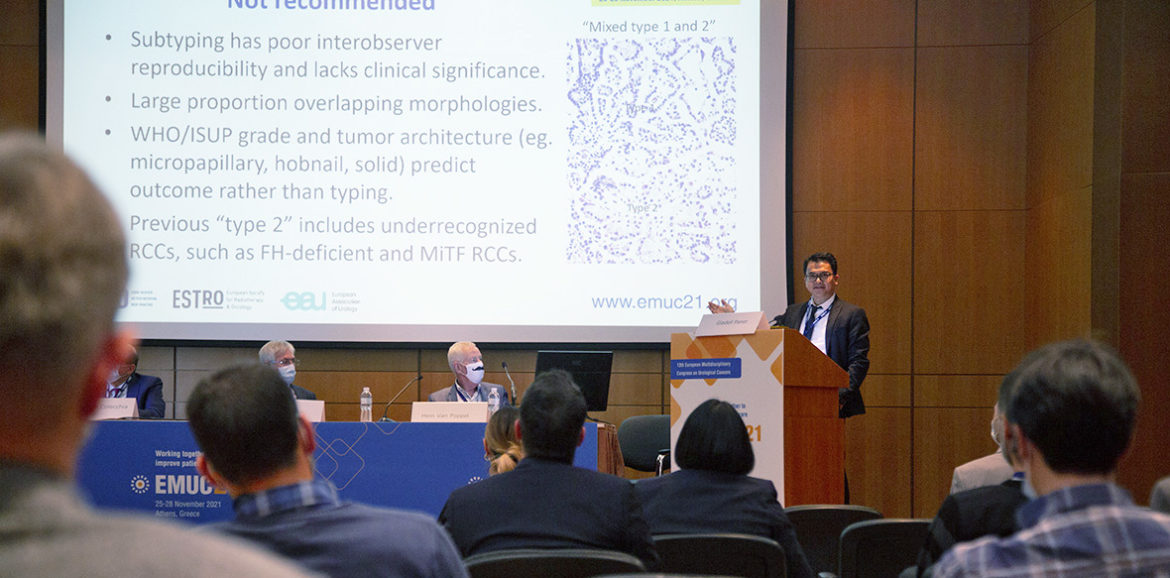The EMUC Symposium on Genitourinary Pathology and Molecular Diagnostics (ESUP) delivered updates and expert insights on topics such as what to expect with the new WHO classification of genitourinary tumours, future directions of prostate cancer grading, and more.
The symposium was chaired by pathologists Prof. Maurizio Colecchia (IT) and Prof. Dr. Antonio Lopez-Beltran (PT), together with Chairman of the EAU Policy Office, Prof. Hein Van Poppel (BE).
In his lecture “Towards a new WHO classification of genitourinary tumours, with emphasis on kidney cancer”, pathologist Dr. Gladell Paner (US) provided a summary of three papers (1) published after the publication of The 2016 WHO Classification of Tumours of the Urinary System and Male Genital Organs. His lecture focused on its updates on renal cell neoplasms and novel renal cell carcinoma (RCC) types.
The updates were as follows:
- Dividing papillary RCC as subtypes 1 and 2 is no longer recommended.
- Drop “carcinoma” in clear cell papillary RCC due to low malignant potential.
- New subset of TFEB RCC defined by amplification not by translocation; this group of tumours is aggressive.
- Group of SMARCB1-deficient RCCs includes mainly medullary carcinoma.
- “FH-deficient RCC” (fumarate hydratase–deficient renal cell carcinoma) is the preferred term over hereditary leiomyomatosis and renal cell carcinoma (HLRCC)-associated RCC.
- Collecting duct RCC with FH-deficient RCC and medullary carcinoma
- Update on grading chromophobe RCC
- Proposed terminology “Oncocytic renal neoplasm of low malignant potential, not further classified” to replace “Hybrid oncocytic/chromophobe tumor” proposed for sporadic cases.
Dr. Paner also enumerated the novel entities such as eosinophilic solid and cystic RCC; anaplastic lymphoma kinase (ALK) rearrangement associated RCC; and RCC with fibromyomatous stroma.
Future directions of prostate cancer grading
During her lecture “Prostate cancer grading: Will ‘Gleason’ survive?”, Dr. Alessia Cimadamore (IT) shared the evolution of prostate cancer (PCa) grading, GUPS and ISUP recommendations, and future directions of PCa grading such as 3D architecture reconstruction of PCa growth patterns, which can show two morphological subgroups:
- The first subgroup comprises Gleason pattern 3, poorly formed and fused Gleason pattern 4, and Gleason pattern 5 cords wherein the vast majority of the tumour cells make direct contact with the surrounding stroma.
- The second subgroup is comprised of cribriform Gleason pattern 4 and solid Gleason pattern 5 wherein the vast majority of the tumour cells do not make contact with the surrounding stroma.
Dr. Cimadamore also discussed the role of computational pathology and AI. She stated, “AI-based algorithms can perform grading at the level of experienced subspecialised uropathologists. There is a potential avenue for improving inter- and intra-observer variability. Additionally, AI-based algorithms could lead to more accurate quantification of patterns. However, more extensive prospective validation is needed in applying AI in routine practice.”
Another innovation Dr. Cimadamore mentioned was radiomics, which she defined as a method based on the extraction of quantitative features from radiological images that cannot be seen by a radiologist’s naked eye and on the use of these data for the creation of clinical decision support systems.
She stated, “There are several papers published illustrating radiomics is able to distinguish prostate biopsy with cancer with another which has no cancer, grade the prostate cancer, and to perform Gleason grading accurately as a pathologist would.”
Dr. Cimadamore concluded that there is a continuous histologic spectrum of gradual changes in prostate cancer. Although histologic grading of PCa is not fully optimised, AI and radiomics will help pathologists in the near future.
She dedicated her lecture to EAU Section of Uropathology (ESUP) Chair Prof. Rodolfo Montironi, whom she considers her mentor.
Watch the full presentations of Dr. Paner and Dr. Cimadamore as webcasts, as well as, other presentations during the symposium via the Resource Centre.
References:
- “New developments in existing WHO entities and evolving molecular concepts: The Genitourinary Pathology (GUPS) update on renal neoplasia” (Trpkov et al., Mod Pathol 2021;34:1392-1424)
- “Report from the International Society of Urological Pathology (ISUP) Consultation Conference on Molecular Pathology of Urogenital Cancers: III: Molecular Pathology of Kidney Cancer” (Williamson et al., Am J Surg Pathol 2020;44:e15-e86)
- “Novel, emerging and provisional entities: The Genitourinary Pathology Society (GUPS) update on renal neoplasia” (Trpkov et al., Mod Pathol 2021;34:1167-84).





